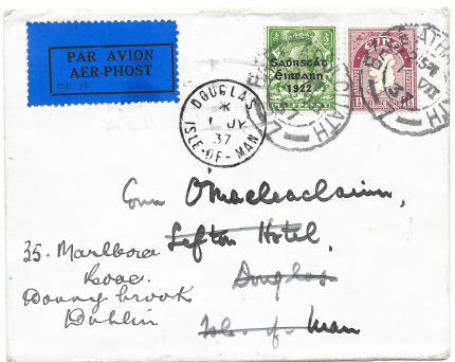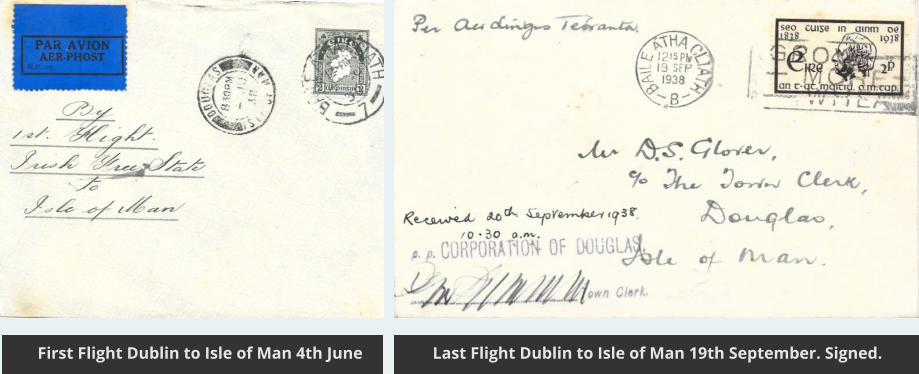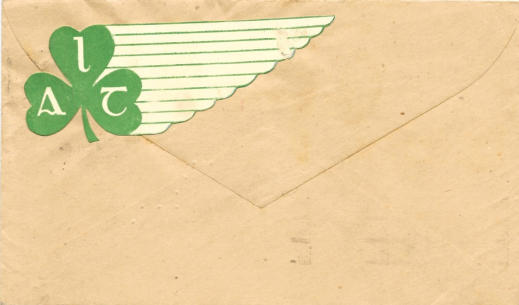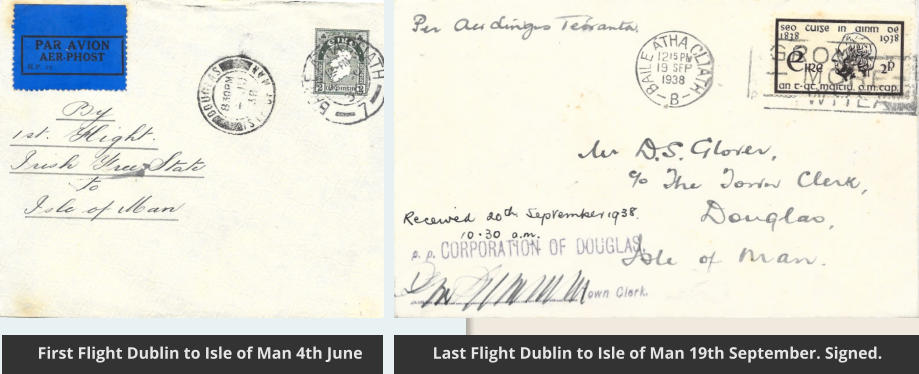
Aer Lingus Teoranta (Irish Sea Airways)
Aer Lingus was founded on 15 April 1936, with a capital of £100,000. Pending legislation for Government investment through a parent company, Aer Lingus
was associated with Blackpool and West Coast Air Services which advanced the money for the first aircraft and operated with Aer Lingus under the
common title "Irish Sea Airways". Aer Lingus Teoranta was registered as an airline on 22 May 1936. The name Aer Lingus was proposed by Richard F
O'Connor, who was County Cork Surveyor, as well as an aviation enthusiast. The word Teoranta is Irish for Limited. On 27 May 1936, five days after being
registered as an airline, its first service began between Baldonnel Airfield in Dublin and Bristol (Whitchurch) Airport, the United Kingdom, using a six-seater
de Havilland DH.84 Dragon biplane (registration EI-ABI), named Iolar (Eagle).
Aer Lingus Three Seasons of Flights 1937 - 1939. Dublin to the Isle of Man.
The service between the Isle of Man and Dublin was instituted by the Irish Postal Authorities as an experiment mainly for Irish holidaymakers in the Isle of Man and in order to facilitate the and expedite the transmission of mail from Dublin to the island. The company issued no special envelopes to celebrate the occasion nor have the company ever applied cachets to flown covers. Because the company did not require Air labels it can be difficult to distinguish between flown and boat mail. Although the passenger service went in both directions, mail was only sent from Dublin to the Isle of Man.First Season July 1st 1937.
The first season started on the 1st July 1937, with a mail carrying flight piloted by Capt. A.L. Robinson flying a De Havilland Rapide. The service continued until the 31st August 1937. Redgrove thought no covers existed from the 1937 season. He was mistaken.
Copyright
© 2022 Robert Farquharson All Rights Reserved

British Internal Airmails of the 1930’s

First flight cover sent from Dublin to Isle of Man and redirected
back to Dublin on the 1st July 1937. This sort of redirection was
done to save picking up a mail sent as a souvenir, and having it
sent back to its originating address free of charge. Baile Atha
Clith (Dublin) postmark. Very scarce.
Second Season June 4th 1938.
The experiment apparently proved a success, as the air mail service was out into operation again in 1938 and for a longer period, namely from 4th June to 19th September. Redgrove thought the only covers existing from that flight were covers that were addressed to Bristol. Once again, he is mistaken. The last flight on the 19th September was flown by Capt. J. Hesketh. 8 souvenir covers were flown, 4 of which were sent to the Town Clerk and signed by him within a purple cachet. Examples of the first and last flight are shown below.
Third Season June 5th 1939.
The third season began on the 5th June 1939. Capt. Ivan Hammond piloted the De Havilland Rapide. The service was scheduled to continue until September 19th but ceased on the 31st August 1939.


Eight souvenir covers were flown on the first
flight, of which this is one. Purple ‘Corporation of
Douglas’ cachet. Signed by the pilot Capt. Ivan
Hammond
This first flight cover sent from Dublin is a round trip.
These are very scarce but when offered are stated as
air mail round trips. This is unlikely. Most probably they
were sent by Air mail and returned by boat. The Isle of
Man postcode is timed at 8.30 p.m., well after the mail
boat and plane had left. Red ‘Irish Sea/Airways’ cachet.
The only mark on the reverse is an Aer Lingus sticker
(ALT Aer Lingus Teoranta).
Eight souvenir covers were flown on the first
flight, of which this is one. Purple ‘Corporation of
Douglas’ cachet. Signed by the pilot Capt. Ivan
Hammond
The only mark on the reverse is an Aer Lingus sticker
(ALT Aer Lingus Teoranta).


First Flight Dublin to Isle of Man 4th June
Last Flight Dublin to Isle of Man 19th September. Signed.

Aer Lingus Teoranta (Irish Sea Airways)
Aer Lingus was founded on 15 April 1936, with a capital of £100,000. Pending legislation for Government investment through a parent company, Aer Lingus
was associated with Blackpool and West Coast Air Services which advanced the money for the first aircraft and operated with Aer Lingus under the
common title "Irish Sea Airways". Aer Lingus Teoranta was registered as an airline on 22 May 1936. The name Aer Lingus was proposed by Richard F
O'Connor, who was County Cork Surveyor, as well as an aviation enthusiast. The word Teoranta is Irish for Limited. On 27 May 1936, five days after being
registered as an airline, its first service began between Baldonnel Airfield in Dublin and Bristol (Whitchurch) Airport, the United Kingdom, using a six-seater
de Havilland DH.84 Dragon biplane (registration EI-ABI), named Iolar (Eagle).
Aer Lingus Three Seasons of Flights 1937 - 1939. Dublin to the Isle of Man.
The service between the Isle of Man and Dublin was instituted by the Irish Postal Authorities as an experiment mainly for Irish holidaymakers in the Isle of Man and in order to facilitate the and expedite the transmission of mail from Dublin to the island. The company issued no special envelopes to celebrate the occasion nor have the company ever applied cachets to flown covers. Because the company did not require Air labels it can be difficult to distinguish between flown and boat mail. Although the passenger service went in both directions, mail was only sent from Dublin to the Isle of Man.First Season July 1st 1937.
The first season started on the 1st July 1937, with a mail carrying flight piloted by Capt. A.L. Robinson flying a De Havilland Rapide. The service continued until the 31st August 1937. Redgrove thought no covers existed from the 1937 season. He was mistaken.
Copyright
© 2020 Robert Farquharson All Rights Reserved

British Internal Airmails of the 1930’s

Second Season June 4th 1938.
The experiment apparently proved a success, as the air mail service was out into operation again in 1938 and for a longer period, namely from 4th June to 19th September. Redgrove thought the only covers existing from that flight were covers that were addressed to Bristol. Once again, he is mistaken. The last flight on the 19th September was flown by Capt. J. Hesketh. 8 souvenir covers were flown, 4 of which were sent to the Town Clerk and signed by him within a purple cachet. Examples of the first and last flight are shown below.
Third Season June 5th 1939.
The third season began on the 5th June 1939. Capt. Ivan Hammond piloted the De Havilland Rapide. The service was scheduled to continue until September 19th but ceased on the 31st August 1939.




First Flight Dublin to Isle of Man 4th June
Last Flight Dublin to Isle of Man 19th September. Signed.





















